Collecting Collectibles (56K beware)
Posted: 2008-05-11 07:10pm
This is a thread about collections, collectibles, knick-knacks, curios, what have you. Be it stamps, coinage, cars, or other curios and relics, I want to see them.
As for my contribution to this thread . . . I collect old firearms. A hundred years old or older, and mostly old Colts. And not just any old cowboy gun either. Double-actions . . . the forerunners to today's modern handguns. So, without further ado:
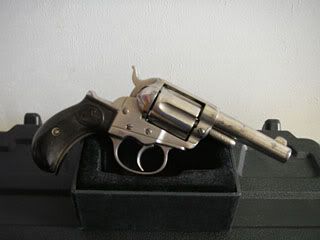
Colt Double-Action Model of 1877. The ones chambered in .38 Long Colt were nicknamed the "Colt Lightning." This one was manufactured in 1883, is nickel-plated, and is no larger than a modern .357 Magnum snub-nose. The old Colt nickel finishes were known for their durability, and this one is no exception. Notable outlaw Billy the Kid carried the 1877 in .41 Colt, as the petite double-action grip was better-suited to his smaller hands.
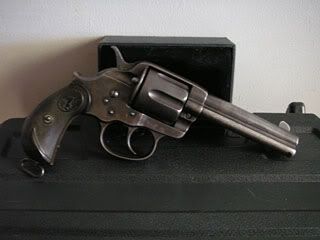
Colt Double-Action Model of 1878. Chambered in all the big-bore calibers of the day . . . .45 Colt, .38 WCF, .44 WCF, .455 Eley, and .450 Boxer. This one is is a .45 Colt with a 4-3/4" barrel, and was manufactured in 1890. It has the letters "H. (upside-down) J. H." engraved on it. The exact significance of this . . . I've no idea. The Model 1878 was Colt's first large-bore double-action revolver. It wasn't as fast to reload as the British Webley top-break revolvers, but was exported to Canada and Great Britain in respectable numbers It even saw service in the Second Boer War as the sidearm of Canadian forces fighting for the British Empire.
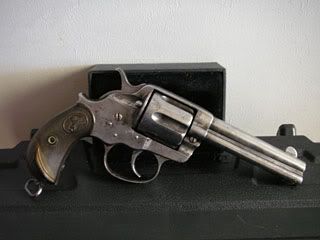
Colt Double-Action Model of 1878. This one was manufactured in 1892. When buyers ordered Colts, many ordered nickel-plating, instead of Colt's blue finish. The reason is apparent here: This gun is actually finished in Colt blue . . . except virtually all the finish has worn off, leaving bare gunmetal. The action, on the other hand, is rock-solid. Loading up some .45 Colt cartridges using the original 255 grain conical lead bullet atop 40 grains of black powder produced big clouds of smoke, and a group smaller than my fist at fifty feet. This one, like the other, sports a 4-3/4" barrel.
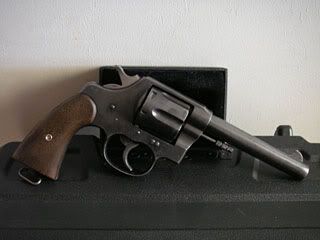
Colt Army Model 1909. This one was in the first batch of 6000 ordered for the U.S. Army in the winter of 1908. An often-overlooked piece of American military history, the M1909 was adopted for the Army occupation of the Philippines as a replacement for the Colt M1895 chambered in the infamously anemic .38 Long Colt, widely derided for being unable to stop charging Moro insurgents. The M1909 was chambered in the .45 Colt, newly-adapted to smokeless powder. It is modern in virtually every aspect (so much so that it goes to the range with me and cuts tight groups using modern smokeless ammo) and was a far superior handgun to the elderly Colt M1873 single-actions hastily ushered back into service early in the occupation of the Philippines, and to the 1878-based Colt M1902 revolvers issued to the native Philippine Constabulary.
If it looks familiar to other military C&R collectors, it's because the gun the M1909 was based on, the civilian Colt New Service, was pressed into service again as the Colt M1917 and chambered in the new .45 ACP cartridge to make up for the shortfall of M1911s going to Europe for WWI.
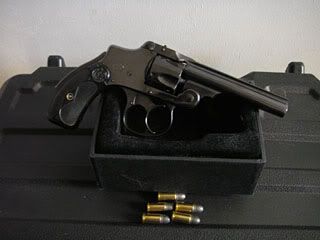
And finally, a Smith and Wesson Safety Hammerless. A (relatively) quick-reloading (it's a top-break,) double-action only gun with a grip-safety and frame mounted firing pin . . . first developed in the 1890s. This particular example is chambered in .32 S&W and was manufactured in or around 1907, and was sent back to the factory for refinishing at some point in its long life, making it look and shoot like it did back in 1907. Even at the turn of the century, safety was on the minds of firearms manufacturers. Anecdotally, the Safety Hammerless was developed to be a gun that a child could not accidentally fire, as these were the low-cost concealed-carry/nightstand guns of the day. To do this, they incorporated a grip-safety which had to be fully depressed in order for the action to work, and a long, heavy double-action trigger pull with just a bit of hesitation right before the hammer fell, enabling surprisingly accurate shooting.
Chambered in .32 S&W and .38 S&W, they give up relatively little in terms of firepower and ammunition capacity to a modern-day Kel-Tec semi-automatic in .32 ACP or .380 ACP. In fact, this one still sees regular "It's 2 AM and WTF is that sound?" service.
(Note: All these pictures point to much larger versions. Just click on 'em.)
As for my contribution to this thread . . . I collect old firearms. A hundred years old or older, and mostly old Colts. And not just any old cowboy gun either. Double-actions . . . the forerunners to today's modern handguns. So, without further ado:

Colt Double-Action Model of 1877. The ones chambered in .38 Long Colt were nicknamed the "Colt Lightning." This one was manufactured in 1883, is nickel-plated, and is no larger than a modern .357 Magnum snub-nose. The old Colt nickel finishes were known for their durability, and this one is no exception. Notable outlaw Billy the Kid carried the 1877 in .41 Colt, as the petite double-action grip was better-suited to his smaller hands.

Colt Double-Action Model of 1878. Chambered in all the big-bore calibers of the day . . . .45 Colt, .38 WCF, .44 WCF, .455 Eley, and .450 Boxer. This one is is a .45 Colt with a 4-3/4" barrel, and was manufactured in 1890. It has the letters "H. (upside-down) J. H." engraved on it. The exact significance of this . . . I've no idea. The Model 1878 was Colt's first large-bore double-action revolver. It wasn't as fast to reload as the British Webley top-break revolvers, but was exported to Canada and Great Britain in respectable numbers It even saw service in the Second Boer War as the sidearm of Canadian forces fighting for the British Empire.

Colt Double-Action Model of 1878. This one was manufactured in 1892. When buyers ordered Colts, many ordered nickel-plating, instead of Colt's blue finish. The reason is apparent here: This gun is actually finished in Colt blue . . . except virtually all the finish has worn off, leaving bare gunmetal. The action, on the other hand, is rock-solid. Loading up some .45 Colt cartridges using the original 255 grain conical lead bullet atop 40 grains of black powder produced big clouds of smoke, and a group smaller than my fist at fifty feet. This one, like the other, sports a 4-3/4" barrel.

Colt Army Model 1909. This one was in the first batch of 6000 ordered for the U.S. Army in the winter of 1908. An often-overlooked piece of American military history, the M1909 was adopted for the Army occupation of the Philippines as a replacement for the Colt M1895 chambered in the infamously anemic .38 Long Colt, widely derided for being unable to stop charging Moro insurgents. The M1909 was chambered in the .45 Colt, newly-adapted to smokeless powder. It is modern in virtually every aspect (so much so that it goes to the range with me and cuts tight groups using modern smokeless ammo) and was a far superior handgun to the elderly Colt M1873 single-actions hastily ushered back into service early in the occupation of the Philippines, and to the 1878-based Colt M1902 revolvers issued to the native Philippine Constabulary.
If it looks familiar to other military C&R collectors, it's because the gun the M1909 was based on, the civilian Colt New Service, was pressed into service again as the Colt M1917 and chambered in the new .45 ACP cartridge to make up for the shortfall of M1911s going to Europe for WWI.

And finally, a Smith and Wesson Safety Hammerless. A (relatively) quick-reloading (it's a top-break,) double-action only gun with a grip-safety and frame mounted firing pin . . . first developed in the 1890s. This particular example is chambered in .32 S&W and was manufactured in or around 1907, and was sent back to the factory for refinishing at some point in its long life, making it look and shoot like it did back in 1907. Even at the turn of the century, safety was on the minds of firearms manufacturers. Anecdotally, the Safety Hammerless was developed to be a gun that a child could not accidentally fire, as these were the low-cost concealed-carry/nightstand guns of the day. To do this, they incorporated a grip-safety which had to be fully depressed in order for the action to work, and a long, heavy double-action trigger pull with just a bit of hesitation right before the hammer fell, enabling surprisingly accurate shooting.
Chambered in .32 S&W and .38 S&W, they give up relatively little in terms of firepower and ammunition capacity to a modern-day Kel-Tec semi-automatic in .32 ACP or .380 ACP. In fact, this one still sees regular "It's 2 AM and WTF is that sound?" service.
(Note: All these pictures point to much larger versions. Just click on 'em.)